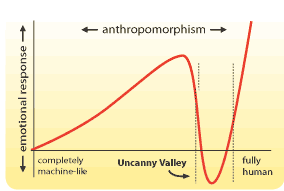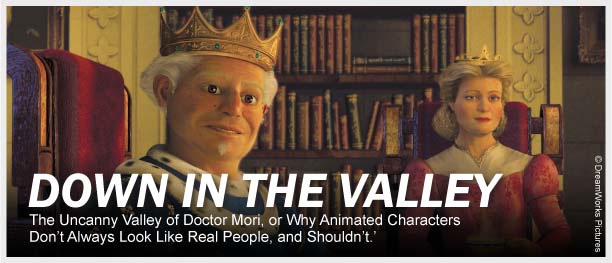Down In The Valley: What Is The Uncanny Valley?
This is a weird one, so approach with caution. Weirdness being the thing so often in the world of animation, with all its monsters, aliens and spirit-beings or what-have-you, what we are concerned with here instead is a theory or thesis by a Japanese robotics guy named Doctor Masahiro Mori, and a certain amount of hubbub among animators recently who have found his ideas to be revealing as it relates to films like ‘The Incredibles’, ‘Shrek’ and ‘The Polar Express’. It’s all very fascinating, but—well—weird.
First of all, the so-called ‘Uncanny Valley’ is really nothing more than a theoretical and perhaps quantifiable relationship between non-human figures such as a robot (or a cartoon character), and how the Average Joe might feel about such a thing based on how closely it resembles something we actually think of as human.
 Huh? Say again? To be more specific, the ‘uncanny valley’ is Mori’s principle of robotics concerning the emotional response of humans to robots. Like, the idea being that if we’re going to create robots, how are we going to feel about the way they look, move, talk, etc.? Mori worked in the late 1970’s through psychological experiments in which he measured human response to robots of “varying degrees of anthropomorphism”. In other words, Robot-A looks like a microwave oven, Robot-F looks like a cute tin-man, and Robot-Z looks like your mother.
Huh? Say again? To be more specific, the ‘uncanny valley’ is Mori’s principle of robotics concerning the emotional response of humans to robots. Like, the idea being that if we’re going to create robots, how are we going to feel about the way they look, move, talk, etc.? Mori worked in the late 1970’s through psychological experiments in which he measured human response to robots of “varying degrees of anthropomorphism”. In other words, Robot-A looks like a microwave oven, Robot-F looks like a cute tin-man, and Robot-Z looks like your mother.
So, it’s kind of like ‘feng-shui’ for robots, or things like prosthetic limbs, or maybe certain appliances, and yes, cartoon characters. Anthropomorphism, you may recall, is the way people prefer to imagine non-human things as having human characteristics. Talking animals are a good example, such as the ancient fables of Aesop, and of course numerous modern films and stories. Animals can’t really talk, but we like to pretend they can, and thus in artwork and so on we grant them this imaginary ‘human’ quality, for fun and profit. Anthropomorphism thus extends to all sorts of things, kind of like a bad intellectual habit, and in the case of robots, Mori was simply looking at human emotions about different robotic appearances and abilities, which were more or less ‘human’, in each case, and so on.
What has intrigued animators, is Mori’s so-called ‘valley’. This can be shown on a graph, but simply stated, Mori’s research indicated that people feel comfortable or empathetic with non-human creations that are made to appear human only up to a point. Like if you have a robot, he may be a simple mechanical man, and that’s fine; you add some human features such as life-like arms and legs, or maybe a human-looking or even goofy face, and that’s pretty cool; but when you go too far, and the robot (or cartoon) resembles a human being too closely, or just enough to bug us—suddenly Mori’s numbers for the emotional response of us real, flesh-and-blood human-types drops off into a steep valley of contempt. Why? Who knows? Perhaps as the non-human begins to approach the human too closely, like a slightly flawed mirror, we glimpse something repulsive about ourselves, a coldness or ‘in-humanity’, that we simply don’t prefer.
Whatever your explanation (and I’m no psychologist), for the global community of animation artists, Mori’s research provides a very practical way of looking at the success or failure of films like ‘The Incredibles’ or ‘The Polar Express’. These were two very different projects, and used different techniques, but they were both created in 3D-CGI. They both also made a lot of money, and were successful in that sense. For each film, the approach of the animators in creating and portraying human characters was very different, with very different results.
In a traditional 2D animation environment, much like any drawing, human characters can be exaggerated, goofy-looking, super-muscled or what-have-you; they may also be ‘realistic’ or ‘natural’. But for the emerging 3D-CGI industry, the portrayal of ‘people-like-us’ (flesh-and-blood real life homo-sapiens), has been a bugaboo that drives artists to distraction. Fans of the medium may recall real-life human characters in the original ‘Toy Story’ (the mom, the various kids), or the animated cast of a film like ‘Final Fantasy’, with much fuss for that one at the time about the ‘realism’ of the animated characters. What Mori is telling animators, is that the emotional feeling or audience empathy for human characters in these types of creations, is actually deeper or greater the ‘less human’ (or more exaggerated, cartoonish) they are. It’s almost a matter of opinion what this really means.
With the $170 million production of ‘The Polar Express’ last year, film-maker Robert Zemeckis and Warner Bothers utilized an advance in ‘motion capture’ technology they called Performance Capture. Anxious for an ‘event’ film, Imageworks visual effects supervisor Jerome Chen created the advanced mo-cap process just for this film. Working with Academy Award-winning effects craftsman Ken Ralston, Zemeckis and the production team hoped for a ‘next generation’ of virtual, CGI performances from actors Tom Hanks, the late Michael Jeter, Charles Fleischer and others.
Motion capture techniques have been around for a while, and are a process by which an actor’s live performance is digitally captured by computerized cameras and sensors, and becomes a human blueprint for creating virtual, CGI characters. The advanced technique created for ‘The Polar Express’ was dubbed Performance Capture, and basically featured much greater sensitivity, flexibility, and so on. The goal was to digitally collect every discernable movement and subtle human expression, down to the actor’s smile, wink or walk, and thus produce more life-like and empathetic on-screen, CGI ‘people’. Everyone made a big deal about it and it was supposed to be great.
Opinions of the results vary, but if Zemeckis and Warner Brothers had consulted Doctor Mori, they may have steered clear of the dreaded ‘Uncanny Valley’, at least in the view of some critics. Film and animation reviewers described the human characters in ‘Polar Express’ as ‘disturbing’, and some people felt the same way about characters in ‘Final Fantasy’ and even ‘Toy Story’. True to Mori’s thesis, Zemeckis’ super-precise CGI Performance Capture on-screen characters have been thought of as ‘doll-like’, ‘stiff’, ‘awkward’, ‘puppet-like’ and yes, ‘robotic’. The film may not have scared a lot of kids, but by giving us CGI characters who were ‘too human’, it turns out they were for some, ‘not human enough’. And thus the ‘Polar Express’ plunges into Doctor Mori’s valley, despite the best effort of some great artists and performers.
So, compare this film with the work of writer and director Brad Bird in ‘The Incredibles’. Here, Brad and his team invented intentionally stylized or ‘cartoonish’ characters for roles like Mr. Incredible, Elasta-Girl, Frozone, Dash and others. Using a very similar CGI approach, but without motion-capture, the animated people in the world of this film are human-looking, but slightly exaggerated. Mr. Incredible’s chest and shoulders are far larger than a normal person’s, giving a sense of gentle strength. Elasta-Girl is very feminine, but of course she can stretch her body to absurd proportions, and she seems ‘cute’. Other characters, like Mr. Incredible’s boss at his insurance adjusting job, are like dwarfs, with big heads and huge faces. Villains are fat, hulky, muscled, etc. Or even spectacularly voluptuous and sexy. Characters also move about very quickly or with great strength, or can zoom around like bolts of lightening, or fly, and actions are protracted to suit the plot in fantastic ways.
According to Mori, this is much more what we like in our non-human, animated counter-parts (or in robots, or even prosthetics).
There are, of course, numerous variables with each kind of story and CGI approach. For one thing, a story like ‘Final Fantasy’ may not be a comedy, but is more serious or dramatic, so cartoonish characters might seem inappropriate. Also, elements such as dialogue, plot, voice-characterizations and so on, all add to the mix that creates our film experience. In the 2D world, characters are routinely rendered in a stylized way, which can be the work of a single artist with a particular ‘look’ (such as ‘The Simpson’ or ‘SponeBob-SquarePants’). The limitless story possibilities of animation and CGI tend toward the fantastic and un-real, but there may also be film-makers who want to use CGI for stories that might be more at home in a live-action format.
So, despite all this pseudo-science or psycho-babble, the conclusion for the animation artist is pretty simple. You don’t like the way CGI characters in ‘The Polar Express’ or similar films look, move, walk, talk, etc.? Doctor Mori’s research and the Uncanny Valley thesis, which preceded CGI techniques by many years, tells us why. Creating art-works that are ‘too human’ or ‘too real’, may after all be a very human mistake, and it may be that animation’s magic mirror on humanity is simply less appealing, the closer we get to the truth about ourselves and our appearance. For which reason I personally always keep a clean pair of colourful spandex tights in the closet, ready for my next battle with fat, hulky, muscled and suitably exaggerated villains.


